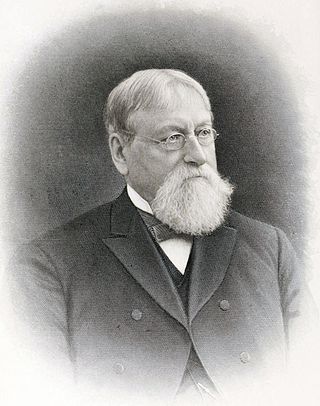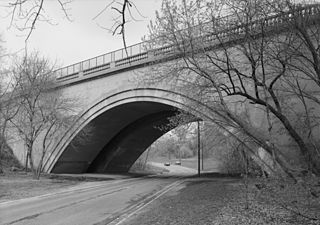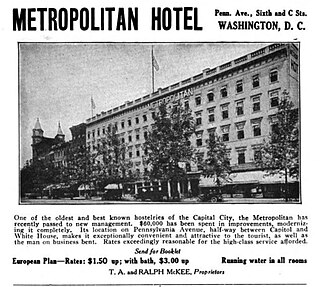John Clagett Proctor (1867-1956) was a local historian, newspaper columnist, and printer in Washington, D.C., best known for a long-running weekly column in the Washington Star newspaper. [1]
Proctor was born November 15, 1867, in a house on New York Avenue NW between 6th and 7th Streets in Washington, D. C. He was the seventh child and second son of Mary Ann (Davison) and John Clagett Proctor, a lawyer and journalist who was then the city editor of the National Republican newspaper. [1]
In 1883, Proctor began printing under Albert J. S. Curet at the United States National Museum. The next year, he received a permanent job at the museum, where he would work until 1906. In the early 1890s, he enrolled in the National University Law School, graduating with a master of laws degree in 1894. He passed the D.C. bar later that year, but never practiced as a lawyer. [1]
Long interested in "history, biography, and genealogy, especially of his native Washington and the neighboring Maryland and Virginia counties," Clagett began speaking at local events on historical topics. In 1902, he began to publish articles and other writings on local history. [1]
In 1928, he inaugurated a weekly column in the Washington Star. In 1949, he published his columns as a book: Proctor's Washington and Environs. [2]
In 1939, the National University Law School gave him an honorary doctorate of laws degree. [3]
Proctor died on April 19, 1956, at his house at 1605 Jonquil Street NW in Washington, D.C. His obituary in the Evening Star pronounced him the "outstanding historian on 19th Century Washington". [4]
In 1964, Milton Rubincam wrote for the Columbia Historical Society:
A dedicated local historian, Proctor contributed extensively to our knowledge of the events that have taken place in the Nation's Capital and its environs. His published writings reflect his interest in every facet of life in this area —social, political, economic, financial, educational, diplomatic, literary, military, even genealogically. [1]

George William Brown was an American politician, judge and academic. A graduate of Rutgers College in 1831, he was mayor of Baltimore from 1860 to 1861, professor in University of Maryland School of Law, and 2nd Chief Judge and Supreme Bench of Baltimore City. He was founder and president of the Bar Association of Baltimore City and the Library Company of the Baltimore Bar.

Brightwood is a neighborhood in the northwestern quadrant of Washington, D.C. Brightwood is part of Ward 4.

Georgia Avenue is a major north-south artery in Northwest Washington, D.C., and Montgomery County, Maryland. In Washington, D.C., and for a short distance in Silver Spring, Maryland, Georgia Avenue is also U.S. Route 29. Howard University is located on Georgia Avenue.
William A. Bradley was an American politician who served as the eleventh Mayor of Washington, D.C. from 1834 to 1836.

Frank Brett Noyes was president of the Washington Evening Star, a daily afternoon newspaper published in Washington, D.C., and a founder of the Associated Press. He was a son of the Star's publisher Crosby Stuart Noyes.

Crosby Stuart Noyes was the publisher of the Washington Evening Star.

Benjamin Franklin Gilbert (1841–1907), an American real estate developer, was the founder of Takoma Park, Maryland, a suburb of Washington, D.C., and the city's first mayor. Gilbert was born in De Ruyter, Madison County, New York.
Thomas Coffin Amory Jr. was born in Boston, Massachusetts, the youngest son of Jonathan Amory and his wife Mehitable (Sullivan) Culter. An American lawyer, historian, politician, biographer, and poet, he graduated from Harvard University in 1830. He became a member of the bar of Suffolk County, Boston in 1834. He served in the legislature of Massachusetts and in the municipal government of Boston.

Theodore Williams Noyes was an American journalist. He was the editor-in-chief of Washington, D.C.'s Evening Star newspaper for 38 years.
John Proctor may refer to:

The Presbyterian Burying Ground, also known as the Old Presbyterian Burying Ground, was a historic cemetery which existed between 1802 and 1909 in the Georgetown neighborhood of Washington, D.C., in the United States. It was one of the most prominent cemeteries in the city until the 1860s. Burials there tapered significantly after Oak Hill Cemetery was founded nearby in 1848. The Presbyterian Burying Ground closed to new burials in 1887, and about 500 to 700 bodies were disinterred after 1891 when an attempt was made to demolish the cemetery and use the land for housing. The remaining graves fell into extensive disrepair. After a decade of effort, the District of Columbia purchased the cemetery in 1909 and built Volta Park there, leaving nearly 2,000 bodies buried at the site. Occasional human remains and tombstones have been discovered at the park since its construction. A number of figures important in the early history of Georgetown and Washington, D.C., military figures, politicians, merchants, and others were buried at Presbyterian Burying Ground.
George Andrews Moriarty Jr. (1883–1968), called G. Andrews Moriarty in most of his published work, was an American genealogist from Newport, Rhode Island. He was born in Newport on February 14, 1883, the only son of George Andrews Moriarty and Mary Ann Sheffield. His ancestor, John Moriarty, emigrated from Ireland in 1777 and settled in Salem, Massachusetts. George attended St. George's School in Newport, and then did his undergraduate work at Harvard University where he earned an A.B. in 1905, cum laude. He then attended Christ Church College in Oxford, England where he specialized in historical studies, following which he returned to Harvard to earn an M.A. in 1907.

The 16th Street Bridge, also known as the Piney Branch Bridge, is an automobile and pedestrian bridge that carries 16th Street NW over Piney Branch and Piney Branch Parkway in Washington, D.C. It was the first parabolic arch bridge in the United States. Construction on the first span began in 1905 as part of the northward extension of 16th Street, and was finished in 1907 but was never opened to traffic. The second span began construction in 1909 and was completed in 1910. The bridge was renovated in 1990, and again beginning in October 2014.

John Wesley Cromwell was a lawyer, teacher, civil servant, journalist, historian, and civil rights activist in Washington, D.C. He was among the founders of the Bethel Literary and Historical Society and the American Negro Academy, both based in the capital. He worked for decades in administration of the US Post Office.
Christian Heurich was an American brewer and real estate investor in Washington D.C. His company, Christian Heurich Brewing Company, established in 1872, was the largest brewery in Washington, D.C. At one point, Heurich owned more land than any other landowner in Washington, D.C., except the federal government.

Morton Luther Montgomery (1846–1933) was a native of Pennsylvania and a Harvard-trained lawyer who became a military and public historian and author of more than a dozen books, lecture-related content, and other materials documenting the history of Pennsylvania from its earliest days through the early part of the 20th century.

Oak Lawn was a large house and wooded estate that once stood on the edge of today's Dupont Circle and Adams Morgan neighborhoods in Washington, D.C. The estate was bounded by 19th Street, Columbia Road, Connecticut Avenue, and Florida Avenue. Previously called Widow's Mite, the estate was originally several hundred acres, but by the 19th century, had been reduced to around 10 acres. The house was built around 1820 and was greatly expanded in 1873 by Thomas P. Morgan, one half of the eponym of the Adams Morgan neighborhood. A large oak tree, nicknamed the Treaty Oak, was reportedly hundreds of years old and stood just a few yards from the house.
Milton Rubincam was an American genealogist who served as a member of The American Society of Genealogists, as well as its president from 1961 to 1964. He was also a notable member of the National Genealogical Society, serving as president of the organization from 1945 to 1949 as well as 1953 to 1954.

The Metropolitan Hotel at Pennsylvania Avenue and Sixth Street NW in Washington, D.C. was a major hotel of the capital city of the United States from 1863 to 1933. Built in 1850 by the heirs of Jesse Brown, the Metropolitan was "brick with marble veneer, originally five stories, approx[imately] twenty bays." In its day it was home "to many distinguished congressmen and visitors." The Metropolitan had a reputation as the hotel of politicians from the Southern states.
Annie E. Rice (1852–1884) was an American physician, and, with Jeannette Judson Sumner, was one of the first two women to attend Georgetown University Medical School, 89 years before Georgetown formally admitted women.












